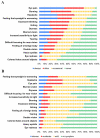Self-Reported Computer Vision Syndrome among Thai University Students in Virtual Classrooms during the COVID-19 Pandemic: Prevalence and Associated Factors
- PMID: 35409679
- PMCID: PMC8997620
- DOI: 10.3390/ijerph19073996
Self-Reported Computer Vision Syndrome among Thai University Students in Virtual Classrooms during the COVID-19 Pandemic: Prevalence and Associated Factors
Abstract
During the COVID-19 pandemic, computer vision syndrome (CVS) related to online classrooms were unavoidable. This cross-sectional study aimed to explore the prevalence, characteristics and associated factors of CVS. A total of 527 students who were currently studying in a virtual classroom (70.40% female, mean (standard deviation; SD) age of 20.04 (2.17) years) were included. The prevalence of CVS assessed by an online CVS-Questionnaire was 81.0% (427/527). Comparing with those in the period before the online study, an increase in screen time (interquartile range) in students with and without CVS was 3 (0−3) and 2 (1−5) h, respectively. Overall, 516 students (97.9%) experienced at least one symptom. The most frequent symptom in CVS subjects was eye pain (96.5%). The most intense symptoms were the feeling of worsening eyesight (15.9%). The factors associated with CVS were female (p < 0.001), age (p = 0.010), atopic diseases (p = 0.020), prior ocular symptoms (p < 0.001), astigmatism (p = 0.033), distance from display <20 cm (p = 0.023), presence of glare or reflection on screen (p < 0.001), low screen brightness (p = 0.045), sleep duration (p = 0.030), inadequate break time between classes (p < 0.001) and increased screen time usage during online study (p < 0.001). Recommendations to prevent CVS based on the adjustable factors might reduce the burden of online study.
Keywords: COVID-19 impact; computer vison syndrome; digital eye strain; digital screen; online study; video display terminal; virtual classroom; visual display terminal.
Conflict of interest statement
The authors declare no conflict of interest.
Figures


Similar articles
-
Prevalence of Self-Reported Symptoms of Computer Vision Syndrome and Associated Risk Factors among School Students in China during the COVID-19 Pandemic.Ophthalmic Epidemiol. 2022 Aug;29(4):363-373. doi: 10.1080/09286586.2021.1963786. Epub 2021 Aug 25. Ophthalmic Epidemiol. 2022. PMID: 34433364
-
Computer vision syndrome and associated factors in university students and teachers in Nampula, Mozambique.BMC Ophthalmol. 2023 Dec 13;23(1):508. doi: 10.1186/s12886-023-03253-0. BMC Ophthalmol. 2023. PMID: 38093208 Free PMC article.
-
Computer vision syndrome: a study of knowledge and practices in university students.Nepal J Ophthalmol. 2013 Jul-Dec;5(2):161-8. doi: 10.3126/nepjoph.v5i2.8707. Nepal J Ophthalmol. 2013. PMID: 24172549
-
Computer vision syndrome: a comprehensive literature review.Future Sci OA. 2025 Dec;11(1):2476923. doi: 10.1080/20565623.2025.2476923. Epub 2025 Mar 8. Future Sci OA. 2025. PMID: 40055942 Free PMC article. Review.
-
[COMPUTER VISION SYNDROME].Harefuah. 2021 Jun;160(6):386-392. Harefuah. 2021. PMID: 34160157 Review. Hebrew.
Cited by
-
Digital Eye Strain among Peruvian Nursing Students: Prevalence and Associated Factors.Int J Environ Res Public Health. 2023 Mar 13;20(6):5067. doi: 10.3390/ijerph20065067. Int J Environ Res Public Health. 2023. PMID: 36981976 Free PMC article.
-
Computer Vision Syndrome Among Medical Students at the University of Khartoum, Sudan: Prevalence and Associated Factors.Cureus. 2023 May 9;15(5):e38762. doi: 10.7759/cureus.38762. eCollection 2023 May. Cureus. 2023. PMID: 37303411 Free PMC article.
-
Cross-Sectional Analyses of Factors Related to Digital Eye Strain Symptoms Among Children Using Online Learning Devices During the COVID-19 Pandemic in Thailand.Clin Ophthalmol. 2023 Jun 21;17:1769-1776. doi: 10.2147/OPTH.S416877. eCollection 2023. Clin Ophthalmol. 2023. PMID: 37366516 Free PMC article.
-
Analysis of the Outcomes of the Screen-Time Reduction in Computer Vision Syndrome: A Cohort Comparative Study.Clin Ophthalmol. 2023 Jan 7;17:123-134. doi: 10.2147/OPTH.S399044. eCollection 2023. Clin Ophthalmol. 2023. PMID: 36644605 Free PMC article.
-
Validation of Binocular Vision and Ocular Surface Assessment Tools in Digital Eye Strain Syndrome: The DESIROUS Study.J Pers Med. 2025 Apr 25;15(5):168. doi: 10.3390/jpm15050168. J Pers Med. 2025. PMID: 40423040 Free PMC article.
References
-
- World Internet Users Statistics and 2021 World Population Stats (Blog) [(accessed on 17 October 2021)]. Available online: https://www.internetworldstats.com/stats.htm.
-
- Advice for the Public on COVID-19–World Health Organization (Blog) [(accessed on 17 October 2021)]. Available online: https://www.who.int/emergencies/diseases/novel-coronavirus-2019/advice-f....
-
- The COVID-19 Pandemic Has Changed Education Forever. This Is How (Blog). World Economic Forum. [(accessed on 18 October 2021)]. Available online: https://www.weforum.org/agenda/2020/04/coronavirus-education-global-covi....
-
- Klamm J., Tarnow K.G. Computer Vision Syndrome: A Review of Literature. Medsurg Nurs. 2015;24:89–93. - PubMed
MeSH terms
LinkOut - more resources
Full Text Sources
Medical

